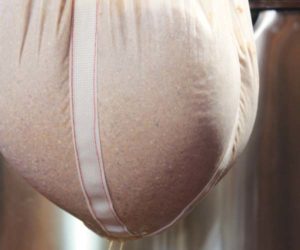The Perfect Crush

My summer crush began in the warmest months of 2017, shortly after quitting my corporate job to work full-time for MoreBeer! I know, most love stories don’t start with a change of occupation. Then again, this isn’t a love story, unless of course you count the love to learn more about brewing. Before signing on full-time, I had been working weekends at my local homebrew shop and a frequently asked question was, “What is the ideal gap setting for my grain mill?” On the surface it seems to be an easy, straightforward question with a simple answer.
There is a good starting range for most homebrew mills, but it’s not one-size-fits-all. The ideal gap setting to produce a “fine” crush on my mill might not work at all for your system and process. Your system might require more of a “coarse” crush to work efficiently. Not to mention that grain is an agricultural product and varies in kernel sizes and friability levels from different maltsters and harvests. Also, mills have different corrugation on their rollers, different roller speeds, and different roller differential (each roller operating at slightly different speeds to obtain more sheer).
That’s the thing, there is no magic number when it comes to gap settings, and that’s why we are told to “mind the gap” and not “set it and forget it.”
Why the crush is important
When you purchase pre-ground malt from most homebrew shops it’s a coarse crush. This is the safest crush that will work on most any homebrewing system, but it’s not the best for efficiency. A lot of published homebrewing recipes take this into account on their grain bills. On a homebrewing scale, throwing a pound or two (0.45–0.9 kg) of extra malt into your batch really doesn’t cost much, but on a commercial scale it adds up over time. Pro brewers need high efficiency to keep the cost per batch at a reasonable level. For homebrewers, great efficiency is more of a bragging right and a demonstration of understanding more than a cost saver.
Knowing the difference between a coarse and a fine crush not only helps with efficiency and preventing a stuck mash, it also helps with consistency. And in brewing, consistency is king! There are a lot of steps down the line that need to be understood to become consistent as well, but it all starts with your first crush (pun intended).
But let’s get back to our story, shall we? I was now working full- time in the industry, doing what I loved, and one of the projects I was involved in had me learning more about malts in general. We were working with Viking Malts to develop a new base malt specifically geared towards the North American market. This is when I first learned how to use grain sieves to examine particle sizes on a crush and what all the attributes on a malt analysis sheet (also called a COA or Certificate Of Analysis) meant. If you have never taken a look at one of these sheets, I would recommend doing so. It might not be as sexy as a hop spec sheet but you’ll find a lot of important information on them.
Since this article is focused on grain mill gap settings, we will primarily be discussing two of the specs listed on these sheets: Friability and lot assortment.
Friability is a measure of how well the kernels modified from barley (which is not friable, or easy to break up) to malt (which is very friable). Low friability indicates that either parts of the kernels didn’t grow well or some complete seeds didn’t grow at all in the malt. Less friable malt will not give up its extract as easily as it is trapped in the unmodified parts by proteins and beta-glucans.
Assortment refers to kernel size. It is sometimes described in other terms depending on the maltster, such as “plump” or “sieving.” The higher the percentage, the larger the kernel size. Assortment is determined by performing sieve tests where four trays are stacked on top of each other with diminishing screen sizes — the top with a 7⁄64-inch screen bottom, the next with a 6⁄64-inch screen, the third with a 5⁄64-inch screen, and a solid tray at the bottom. After shaking the trays, the percent of kernels in each tray is measured, and the percent that are caught by the top two screens are added to make up the lot assortment percent. The smallest grains that fell through all of the screens and made it to the pan are often referred to as “thrus.” The thrus are very small kernels that can be almost unmillable. Maltsters also classify the kernels caught in the 5⁄64-inch screen differently. For instance, Briess refers to these malts as “thins,” while the larger malts that were caught in one of the two larger screen sizes are referred to
as “plump.” It is difficult to properly mill the thins without crushing the plump portion when using just the single crush of a two-roller mill.
My original idea for this article was to crush several base malts at different specs. Then sieve test and perform a Congress Mash as well, reporting the results of both tests. After talking with a friend who has been doing this a lot longer than I have, he talked me into just focusing on the physical attributes of malts for this article. So we will save diastatic power and extract for another article.
Around the same time I started working on this article, Admiral Maltings, a local northern California maltster located in Alameda, sent out a marketing email saying they are now offering different milling specs on their pre-milled sacks of grain. My eyes lit up with beer geek love when I saw that. I had worked with the team at Admiral in the past with my homebrew club and thought who better to talk with about the physical attributes of malt than a maltster. Head Maltster Curtis Davenport was kind enough to answer my questions and walk me through their entire floor malting and testing processes step-by-step. In the sidebar at the bottom you can read a part of the Q&As from that day.
Having talked with a malting expert, I confirmed friability and kernel size assortment should have some impact on my crush research. But how much, and could I detect it by running sieve tests? So, I identified my question, it was now time to experiment.
On to the experiments

I selected four different base malts – Viking Xtra Pale, Rahr 2-Row, Briess 2-Row, and Admiral Gallagher’s Best. I then used a 2-roller homebrew mill and crushed the malts using four different gap settings. The gap settings were 1.25 mm, 1.0 mm, 0.75 mm and 0.50 mm. I used a feeler gauge to verify these settings in between each milling. I then performed a grain sieve test on the different malts and crushes, recording the results.
The method for performing a sieve test is pretty quick and straightforward. But let me tell you, doing 16 of them does take some time. You place three small rubber balls on each of the US standard test sieves #14, #30, and #60 and then place the bottom pan under the #60 test sieve. They must be stacked in the proper order with the widest screen being on top (#14) and the finest (#60) on the bottom before the pan. The grain sample being measured is then placed into the top sieve and the lid is put on prior to performing the test process.
I used 100 grams of each crushed malt to keep the math easy, but you can use up to 130 grams for this test with the US standard test sieves. The sample should be a good representation of the crush and include husks, kernels, and powder.
When performing the test, you need a smooth, flat surface, as you will be sliding the test sieves back and forth for several minutes. The sieves need to travel 18 inches (46 cm) in one direction and then the other, taking 0.5 seconds each way for a total cycle time of one second. Every 15 seconds you tap the sieves and pat downward on the working surface. This cycle is maintained for three minutes total. You then empty each individual sieve, being sure to brush them out completely, then weigh and record the results. Calculate the percentage for each sieve by dividing each fraction by the sum of all fractions weights and then multiply by 100.
Example:
#14 + #30 + #60 + Pan = Sum
Then:
#14 / Sum x 100 = percentage
This example equation will give you the percentage malt that was left on top of the #14 sieve. Repeat the equation for screens 30, 60, and the pan. Since we are using 100 grams of sample material, the percentages will be very close to their original fractions.

Having known the friability and lot assortment (Figure A, below) of these malts prior to this test, I originally suspected there would have been a greater variance. To my surprise, the greatest gap (pun intended) in percentages was 7%. Still, that’s almost enough of a difference to take you from a “standard” to a “fine” crush (Figure F, below) with the same gap setting by simply switching base malts. You can see why brewers are told to “mind the gap.”
But it’s not just an aphorism for a gap setting, it’s about understanding and checking with each batch you brew. I was also surprised at the percentages of fine particles that made it into the pan based on the milling spec sheet (Figure F). But looking at the different crushes (below), I would use some of the ones bordering on the low fine territory. It’s really dependent on your system though. A friend of mine who is opening a brewery in Hawaii is putting in a mash filter system. With that type of system you would use an extra fine crush and achieve really high efficiency.
As for the original question of “What is the ideal gap setting for my grain mill?” let’s assume we are talking most 2-roller homebrew mills with a 1.25-inch (3.2-cm) diameter roller and you are also using a mash tun with a decent false bottom. I would start with a little over 1.0 mm and go from there. If you don’t have feeler gauges you can use a credit card (normally 0.76 mm) to help measure it (or run down to the local auto parts store and buy a set for a few bucks). Ideally, you want to find a highly efficient but not troublesome (meaning it won’t cause a stuck mash) crush that works for your brewing system. It’s not necessarily going to be solely based on a gap setting either, as the same malt can change from year-to-year, like Admiral’s Head Maltster Curtis Davenport mentioned. Similar to how we must adjust hop additions based on alpha acid%, we also need to adjust gap setting based on how the crush comes out of the mill if we want consistency. As long as you are monitoring this step in your process, over time you will develop an eye for it.
Milling your own grain not only allows you to use the freshest possible ingredients, it allows you to dial in your crush for maximum efficiency. Plus, the smell of freshly crushed malted barley is pretty awesome.
Just remember that gap settings are not universal, so the crush should be monitored every milling to ensure the barley you’re working with is being properly crushed. Barley is an agricultural product and friability and kernel size assortment vary from maltster-to-maltster and even harvest-to-harvest.
Sieve tests can be performed at home and will help you understand and dial in an ideal crush for your system. These sieves can be found online for a moderate investment. But by simply paying attention to your crush and monitoring it, each batch will help you develop an eye for it over time. A consistent crush equals consistent batches, and brewing consistency is a sign of a good brewer.

Q&A with Curtis Davenport of Admiral Maltings
Admiral Maltings was founded in 2017 by two long-time San Francisco brewing industry veterans, Ron Silberstein of ThirstyBear Brewing Company and Dave McLean of Magnolia Brewing Company, along with Head Maltster Curtis Davenport, who has an extensive background in organic farming and small-batch malting. To learn more about the importance of the crush, I sat down with Curtis to get a maltster’s point of view.
What should I look for on a COA in regards to milling?
“I would look at friability and kernel size assortment. It’s good to look at the COAs and be familiar with the malt, but there is no formula you can gather. Ultimately, it’s your observation that matters, but you can look at the COA and understand your observations.”
What is friability?
“It’s the ability for the malt to be crushed. How much of the kernel was crushed when there was pressure put on it. For low friability you would need a tighter mill gap setting.”
What is kernel size assortment?
“It’s calculated by counting the weight of kernels in a sample assortment caught on different malt screens. These malt screens are 7⁄64, 6⁄64, and 5⁄64 of an inch. This number will change because barley size changes from year to year and the maltster does not have control over that.”
What is the ideal gap setting for a standard crush? (I had a big smile on my face when I asked this one, but I felt I had to do it for the sake of journalism.)
“Our standard gap setting is not the same as another brewer’s due to our roller sizes. It’s really about seeing what is coming out of your mill and adjusting based on that. The best thing to do is run your mill and run a sieve test prior to setting your gap. Or just run a little then look at it and adjust based on what you’re seeing.”



